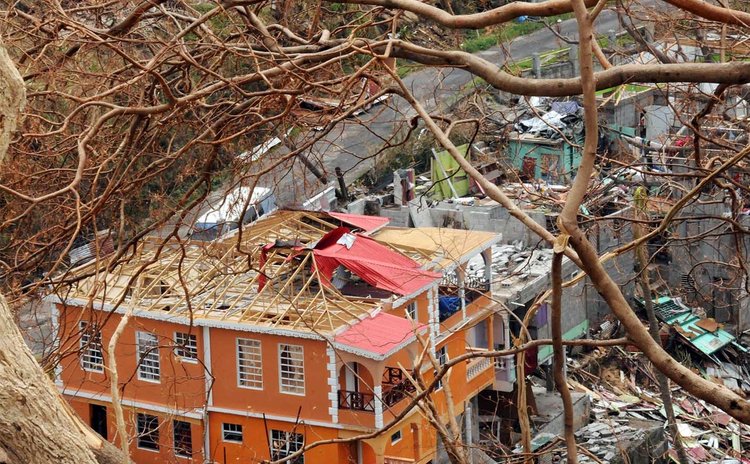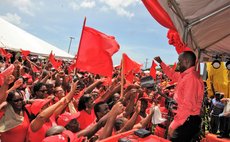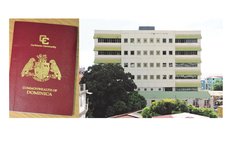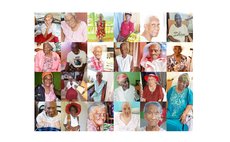No, not really: Dominica has not "recovered" from the devastation of Hurricane Maria

Dominicans were counting their blessings, giving thanks and remembering, and more than a few were thumping their chests with pride, last week Thursday, September 17, the anniversary of the pounding that the island received in 2017 at the hands of category-five Hurricane Maria.
Many people have observed the many physical scares that have been healed, mainly through the resilience of nature and so have erroneously concluded that their island home has "recovered" from the devastation of Maria.
But we disagree.
Yes, the vivid-green mountains and valleys have returned; the mountains of garbage and galvanize sheets and hills of mud have been cleared; the grave yards of massive tree trunks on banks of rivers and on sea shores have disappeared; the houses, hundreds of them, have been repaired and other structures, such as bridges and roads and schools, have been repaired, to a certain extent. And members of the business community have resorted to the Court for redress for the wanton looting, the second hurricane, that occurred for days after Maria. If that is your version of "recovery" then let's welcome you to another world.
But no, this island is still suffering immensely from the massive psychological damage that the storm wrought on the inhabitants.
And more significantly, the island's economy is still in tartars; sectors such as agriculture, tourism and manufacturing have not "recovered" and will not completely recover to pre-Maria levels for many, many years, probably decades.
The point is, if you accept that the level of damage that Maria inflicted on Dominica, one of the poorest islands in the Eastern Caribbean, was mindboggling, how could you explain its "recovery" in three years?
Look at the statistics of Maria's destruction for a while, from an executive summary of a document prepared by the World Trade Organisation (WTO).
"Hurricane Maria provoked damage estimated at 226% of GDP. Some 1.8 million work days were lost across tourism, agriculture, and commerce. Commerce and the micro-business sector suffered damage to the tune of US$ 70.4 million. Damage and losses in the agriculture sector were substantial. Agricultural production including crops, infrastructure, equipment, and croplands, was affected. Furthermore, high winds and intense rainfall damaged the forest system."
Note that 20,000 Dominicans left Dominica after Hurricane David in 1979 and a similar number may have migrated in 2017. If the government knows how many of its citizens left after Maria 2017, it has not released that information. But how does a country "recover" when thousands of its youngest, most able-bodied members of its work-force disappear?
It's obvious that tourism has not recovered –just take a look at just three hotels-the Garraway, Fort Young, and Anchorage Hotels- in Roseau and its environs.
There is a similar story in the agriculture sector – remember that tree crops take five to ten years from planting to optimum production. In Grenada, for example, the nutmeg industry was destroyed by a hurricane in 2002; it took a decade for nutmegs to return in the Spice Isle. People who glibly say that Dominica has "recovered" from the destruction of Hurricane Maria conveniently forget the impact that the departure of the 2,500-student strong Ross University School of Medicine of Picard in Portsmouth has had on the Dominican economy.
Recall that on 3 August 2018, about 11 months after the passage of Hurricane Maria, the medical school announced that it planned to relocate to a new campus on Barbados. The university campus and the sprawling hotels, guesthouses, apartment buildings, supermarkets and restaurants in Picard remain empty.
Can an island recover that easily after losing 15-20 % of its Gross Domestic Product?
Hence, as Dominicans remembered the horrors of Hurricane Maria they must also be weary of faulty arguments that Dominica has somehow recovered completely from Maria. Nothing is further from the truth.
The truth is recovery, real recovery, will take consistent and persistent action for many decades.
"Economic output in Dominica is projected by the IMF to drop by 14 percent in 2018 and will take around 5 years to recover to pre-hurricane levels," says the WTO document that we quoted earlier. "Disasters have large and enduring economic effects".
We continue to argue that Dominica has not completely recovered from the ravages of category five Hurricane David four decades ago, especially from the mass exodus immediately after the storm. It will take as long for the country to recover from Maria.
And our view that there will be more Maria-type hurricanes to come is backed by solid science.
For example, in a study published in the journal, Climate and Atmospheric Science, in June, NASA scientist Tim Hall found that North Atlantic hurricanes have slowed about 17 % since 1944; annual coastal rainfall averages from hurricanes increased by about 40 % over the same period and a 2018 paper found that tropical cyclones worldwide have slowed significantly.
Understandably Dominicans are scared of the annual hurricane season because they have not recovered, physically or psychologically, from the battering they received from Maria or even Hurricane David.
Of course, the best way to survive these increasingly frequent and more devastating natural disasters, made worse by the phenomenon of climate change, is to prepare like we have never prepared before.
For Dominicans the 2020 hurricane seasons has been especially painful because we have not had the opportunity to build back better, as government's slogan suggests.
Let's not fool ourselves. Rebuilding after Maria has not been as easy as we have been led to believe. Dominica, like Puerto Rico, is still a major hurricane-battered country. Many parts of the island, where the poorest of the poor live, still bear the scars of being battered by the hurricane and that condition, for a large number of the poorest Dominicans, will continue for many years.




